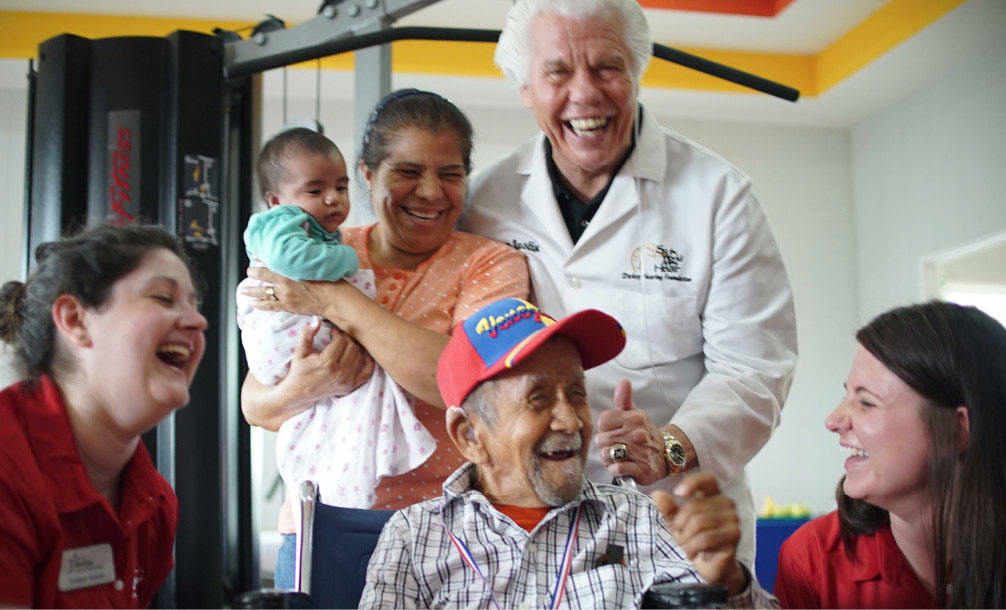A n overjoyed woman was speaking to him in Swahili, but Brady Forseth couldn’t understand her. The woman’s 15-year-old son, who contracted malaria at a young age and lost his hearing, had just heard sound for the first time after Forseth installed a hearing aid. The woman, her son and the boy’s two brothers jumped up and down with elation. The boy’s mother kept ecstatically speaking to Forseth, but he had no idea what she was saying.
An interpreter translated: “For what you just did for my son, you’re now my fourth son, and I will never forget as long as I live.” The family had walked more than 9 miles through the bush to Kisumu, Kenya, to find treatment for the hearing-impaired teen.
“I can tell you there are not enough tissues in a Kleenex box to wipe the tears of joy streaming down,” Forseth says.
In his role as executive director of philanthropy for the Starkey Hearing Foundation, Forseth says moments like this one happen all of the time.
Related: How to Make Others Feel Significant
The foundation was started in 1984 by William F. Austin, who remains the CEO of Starkey Hearing Technologies. In 2000 Austin’s wife, Tani, was named a co-founder and joined the foundation to spearhead its mission: So the World May Hear. The foundation provides hearing aids to those in need around the world through hearing missions. People suffering from hearing loss in developing countries are often unable to find help and forced to go through life in silence. This poses long-term challenges such as finding work, and day-to-day problems such as simply getting around.

STARKEY HEARING FOUNDATION
“It’s more than just [helping them] hear,” says Richard Brown, who oversees long-term strategic vision as president of Starkey Hearing Foundation. “It’s connecting them with their family. It’s connecting them with a community. It’s taking away the isolation.”
The missions come in three phases: Phase 1 involves screening and identifying patients, taking ear impressions, and creating custom ear molds; during Phase 2 the patients receive their hearing aids as well as instruction on proper maintenance; Phase 3 involves ongoing monthly services with patients and searching for new people to treat.
“We use hearing as a vehicle of caring and understanding,” Tani Austin says. “[With hearing loss] there’s no pain, there’s no blood, and it’s invisible so people can always put it off. But there is such a quality in life when we’re able to help them.”
Related: What Do You Get from Giving? (3 Things, Actually)
Since her first trip with the foundation to Mexico in 1993, Austin says she’s been on more hearing missions than she can count. Her most memorable trip was to Malawi in September 2013. There, Austin helped a woman in her 50s named Gladys, who needed her hearing aid repaired. Gladys arrived too late to receive help during the day. Afraid she had missed out on her opportunity to receive care, Gladys was overcome with emotion and gratitude when Austin stopped on her way back to the hotel to assist her. Austin says she keeps a photo of Gladys on her desk.
“People are afraid they’ll miss it or we’ll run out of supplies. You see the fear and the hope in their faces all at once,” Austin says. “What’s so breathtaking is to see [that fear] go away the instant sound hits the brain. You’re watching biology happen. You can see someone hear. It’s like a light switch…. People will stop, and then they’ll look around like, Is this real? Is it really happening? And then they just go into sheer joy.”

STARKEY HEARING FOUNDATION
In its 32-year history, the Starkey Hearing Foundation has visited more than 100 countries across five continents. It has provided more than 1.9 million hearing aids to those in need and now provides more than 200,000 hearing aids each year.
“It’s about showing people dignity and respect—showing them that they have value and self-worth. “Ultimately our goal is to give people hope.”
“It’s about showing people dignity and respect—showing them that they have value and self-worth,” Forseth says. “Ultimately our goal is to give people hope. Every mission has been a mission of hope for these people so they can mainstream into life.”
Brown says the foundation is continually looking for ways to expand so people can receive treatment long after the hearing missions leave a city. In May the foundation opened its first institute in Zambia, a country where more than 900,000 people don’t have hearing care. The goal of the Starkey Hearing Institute in Zambia is to help more than 2 million people in Africa by 2030.
In his first three years working for Starkey Hearing Foundation, Brown says he went on more than 20 hearing missions. Nowadays he doesn’t travel as often but still joins at least a few missions each year. The trips have had a lasting impact on his life.
On one of his first hearing missions, Brown helped a 12-year-old girl with hearing loss and saw the girl hear her mother say I love you to her for the first time in her life. “Sometimes we take things for granted,” Brown says. “I’m much more understanding of situations and people now. Traveling all over the world and seeing the commonality of what people are looking for has definitely made me a much better person.”
Austin, who spent three-quarters of 2015 traveling on hearing missions, says each trip pushes her to do more. “It has made me want to set an example for others and just not be satisfied with a desk job. Let’s do better. Let’s do more. There’s always someone else who needs our help.”
Related: 3 Steps to Build More Meaning Into Your Business
This article originally appeared in the October 2016 issue of SUCCESS magazine.









